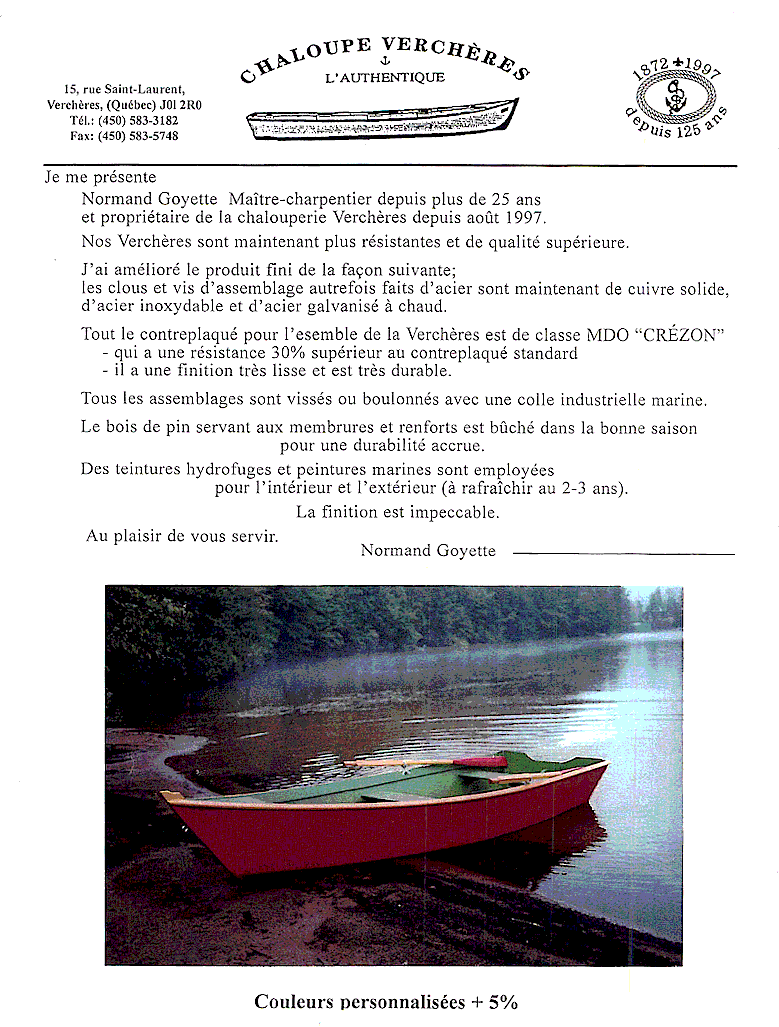|
|
![]()
|
Chaloupe Vercheres
|
|
Sometimes, the world is really small. After immigrating to Montreal, Canada, we met a former neighbor and friend of my wife who had lived around the corner from her in Amsterdam, The Netherlands. After a few years, the friend and her husband moved to Tracy, Quebec where he was working at the shipyard. Tracy is a little town half way between Montreal and Quebec City on the South shore of the St-Lawrence River on route 132. He made a nice swimming pool in their backyard, and we both had children of the same age. That made it an ideal place for a visit on a hot Sunday afternoon. That is how I discovered the municipality of Vercheres, the one-time capital of the Chaloupes Vercheres.
From the border between the USA and Canada, opposite Cornwall, Ontario, the scenic route 132 hugs along the south shore of the St-Lawrence River bypassing Montreal and Quebec City and going all along the Gaspeī peninsula to the province of New Brunswick. About 50 years ago it was the main road between Montreal and Quebec City toward the Maritime Provinces. On this road, Vercheres is about 60 kilometers east of Montreal. This little municipality - with approximately 350 inhabitants at that time - used to be THE boat building capital of the French-Canadian chaloupes. The chaloupe is a kind of dory-skiff with lower sides and a wider beam as can be seen in the photographs. She is developed from a Double-Ender also shown in the pictures.
Chaloupe building in Vercheres started in the late 1800s as a small house industry. The reliability of the boats spread fast and from just before WW II to the late 1960s there were as many as 10 boat shops producing chaloupes of all sizes. The saying is that bad things always happen in threes. In the early sixties, a direct new highway, part of the Trans-Canada between Montreal and Quebec City, was completed. The new road substantially shortened the trip between these destinations. It also completely bypassed Vercheres. It changed the coastal road into a rural back road and robbed the boat builders of the exposure of their boats to the bypassing public. At the same time aluminum and fiberglass boats hit the market. They were highly advertised, and they also need a lot less maintenance than their wooden counterparts, as they donít dry out during the storage period in the winter season. The fact that the chaloupe builders spoke mostly French did not help either.
When I step closer, the second thing that attracts the eye is the impeccable way in which the boats are finished. This is the work of a real craftsman with pride in his work and one who really put his soul into it. That impression is strengthened when I shake hands with Normand Goyette, the present proprietor since 1997 of the last boat building shop in the municipality. He introduces himself as charpentier (carpenter). Then, with a flash of fierce pride, he corrects himself: MAITRE CHARPENTIER (master carpenter). The way he says it forces me to write this with capital letters. It does not sound conceited at all. Here is a craftsman who goes at the work on hand with heart and soul. Alas, there are not many boat builders like him left. He belongs to the barely surviving few of a proud group of the severely endangered species of professional wooden boat builders.
In the following bilingual discussion, my bad French and his broken English, it turns out that he uses high quality MDO plywood called Crezon for his works of art. And yes, business could be a lot better. Then comes my biggest surprise. It turns out that there are no drawings available. They are built by eyesight. I think you all will enjoy seeing a copy of the first page of the leaflet, and the photographs. It may even give you some ideas. Sheers and Chines, Barend |

Home | Articles | Books | Columns | Projects | Links | Subscribe | Boat Index |